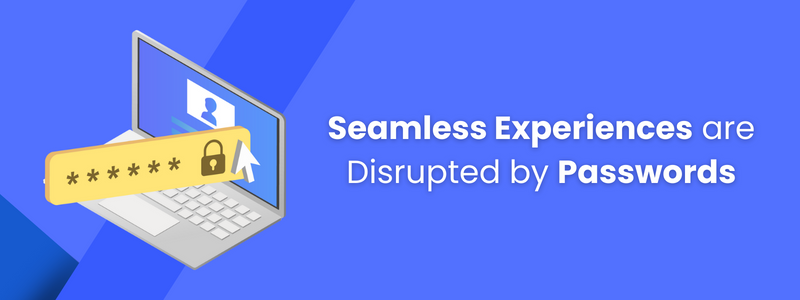Seamless Experiences are Disrupted by Passwords

Developers and technology leaders must assess if the conventional passwords technique will work in the modern digital era as cyberattacks get more sophisticated and customer desire for seamless user experiences increases.
The risk of credential theft can be decreased by providing your clients with single-step passwordless multi-factor authentication (MFA).
Key Security goals
- Decentralize identity
- Leverage advanced cryptography to validate users
- Seamlessly onboard existing users to single-step
- passwordless MFA
This eliminates the need to maintain unsecured usernames and passwords for application developers and owners. The platform makes it simple to give current users a smooth and constant digital experience across all platforms as they transition to a better authentication experience.
Future encrypting systems
Passwords are expensive. Still, passwords are the weakest link in the digital era and present security threats to customers, partners, and enterprises. According to Verizon’s 2021 Data Breach Investigation Report, credentials are taken through social engineering or brute force hacking in 61% of all data breaches.
Passwords have also given consumers endless reasons to be frustrated. Developing original passwords and following various alphanumeric password policies might be difficult. Employee and partner productivity suffers, as well as revenue and customer conversions when end-user friction is present during sign-in; This can be very expensive, especially since 83% of customers have given up on their shopping cart or sign-up due to a complex login process.
FIDO2 for Authentication
Most people adore FIDO2 for the critical security solutions it provides. The Phone-as-a-token (Phaat) authentication mechanism has enormous market traction in organizations where hardware tokens are less widespread, making it a more widely used alternative to FIDO2 in the short-to-mid term.
As a result, this paper will focus on substitute solutions for passwordless authentication in situations where businesses cannot or will not wait for widespread FIDO2 implementation.
Passwordless Authentication Implementation in 3 Steps
It need not be expensive or labor-intensive to introduce passwordless authentication. In reality, it is possible to effectively alter current net investments to include passwordless authentication. These first three phases will assist you in determining where your efforts should be directed.
Identify your clients’ demands, inclinations, and security risks Profiles
Defining your goals and identifying the drivers, namely your users, should come first. Do they use mobile phones, laptops, desktop computers, etc.? Your users may need various levels of security and user experience depending on their behaviors and needs.
Think about how the following key strategic authentication implementation goals match your customers’ demands to address these.
- Passwords should not be used or stored anywhere in the infrastructure.
- The probability of account takeover (ATO) and digital identity theft is minimized
- Avoid causing more conflict because of forgotten passwords.
Review your system and available resources
Passwordless authentication does not always require spending money on tearing technologies. To satisfy your client’s expectations, enhancing or changing the current authentication procedures such that passwords are not required (see figure below). In this case, authentication can be done without a password by utilizing any possible signals and credentials. For instance, they might use biometrics to achieve password-free authentication.
Utilizing recognition and risk signals is another more sophisticated passwordless authentication technique that improves the frictionless user experience (see figure below). Here, signals and particular circumstances play a significant role in passwordless authentication. If these satisfy specific requirements, the user may log in using adaptive authentication, commonly known as zero-factor authentication (0FA); If not, the user is required to log in using a more conventional MFA step.
Shorten the time to value
There are two mainstream methods for directly replacing password authentication.
- One-factor authentication methods include out-of-band SMS, mobile push, or one-time passwords.
- PIN or biometric authentication are examples of multi-factor authentication and passwordless techniques.
The use of a phone as a token in a single-factor authentication approach is demonstrated in the first section. The second section offers a multi-factor authentication example using a phone as a token (MFA). A PIN or biometric authentication can be added to the mobile push or OTP in the MFA example to substitute a password.
For clients who don’t use mobile phones, OTP hardware tokens can be a substitute for them very easily.
Final fact
Organizations and users will both be responsible for maintaining passwords and enforcing and adhering to sensible password standards as long as passwords are used in login processes. As a result, the weight of passwords will negatively impact both customer security and user experience.
These are the most convenient and straightforward alternatives because they are all already available as passwordless MFA authentication by design. You may also like our recent blog: JumpCloud Launches Password Manager
Visit F60 Host if you want to learn more about Jumpcloud and Cloud Directory services
